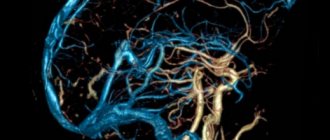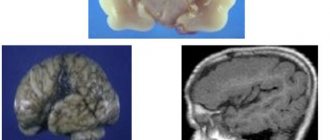| Profound mental retardation | |
| ICD-10 | 73. |
| ICD-9 | 318.2318.2 |
| DiseasesDB | 001523 |
| MedlinePlus | 001523 |
| eMedicine | med/3095 neuro/605neuro/605 |
| MeSH | D008607 |
Idiocy
or
idiocy
(from ancient Greek ἰδιωτεία - “isolation; ignorance, lack of education”; English idiocy) is the deepest degree of oligophrenia (mental retardation), in a severe form, characterized by an almost complete absence of speech and thinking. According to a number of psychiatrists, the terms “idiocy” and “idiot” are outdated and not recommended for use, since they have gone beyond a purely medical framework and have begun to have a social (negative) connotation[1]. Instead, some guidelines suggest using the neutral term from ICD-10, according to which “idiocy” corresponds to the diagnosis of “profound mental retardation” or “profound mental retardation”[1]. Nevertheless, in the psychiatric literature and literature on oligophrenopedagogy, the traditional terms “moronism,” “imbecility,” and “idiocy” continue to be used [2][3][4][5].
Amaurotic idiocy
It is one of the most difficult variants of this most difficult diagnosis. In patients with amaurotic idiocy, the pathology progresses as they grow older. In a short time, the degradation of intelligence begins, which in a short time reaches the level of complete idiocy with a lack of reaction to any external stimuli. The patient's level of vision decreases, leading to complete blindness. Doctors identify a special structure of the fundus of the eye in those suffering from this pathology.
At the moment, the exact causes of the disease have not been identified. Observations of patients suggest the presence of a hereditary predisposition; pathology is often observed in related marriages. At birth, the baby suffers from hydrocephalus. He suffers from seizures and paralysis. Life expectancy does not exceed several months.
Use in colloquial speech
The term “idiocy” in Russian is used as a common name for congenital dementia, as well as to designate any nonsense, stupidity (colloquial term)[12]. An example of phrases that reveal the meaning: “Some kind of idiocy!” Or, for example, the phrase used in the memoirs of Grigory Gorin: “The idiocy of our censorship!” Usually, no one who uses this word implies the corresponding psychiatric term, focusing more on the absurdity, unreasonableness, or stupidity of the situation.
Moronic idiocy
Debility is one of the degrees of mental retardation. This pathology can be either congenital or acquired. Among the reasons leading to debility, doctors note the following factors:
- hereditary predisposition, including generative pathology of the cells of the patient’s parents, in this case Down’s disease, true microcephaly and other pathologies of a similar type may develop;
- infection of the embryo or fetus during intrauterine development when the mother suffered during this period diseases such as rubella, syphilis, toxoplasmosis, and other infections caused by viruses;
- harmful factors that the child had to endure in the first three years of life, including head injuries, conflict between the Rh factor of the mother and the fetus, birth injuries and more.
Such patients can, with proper training, take care of themselves; they are educated in auxiliary schools. Some patients are partially gifted. With low overall thinking productivity, they, for example, can do mental arithmetic well. Patients may be apathetic or, conversely, have an increased level of excitability.
Causes of oligophrenia
Reasons that provoke the disease:
- endogenous factors (impaired intrauterine development of the fetus);
- exogenous (external - injuries, tumors, etc.);
- a set of reasons.
Endogenous factors include hereditary diseases , genetic and chromosomal mutations, exposure to chemicals on the embryo - drugs, alcohol, radiation, severe maternal stress, infectious and viral diseases of the pregnant woman. Intellectual deficiency can also be caused by complications during pregnancy - disruption of placental blood flow, Rh conflict, hormonal disorders of the mother (diseases of the thyroid gland, adrenal glands, etc.).
External causes that can provoke oligophrenia include birth trauma, asphyxia and hypoxia of the fetus, serious infectious diseases - encephalitis, meningitis. Mental retardation is also caused by severe brain injuries and tumors.
It is important to remember that the clinical picture of oligophrenia depends not only on the causes , but mainly on the development of the child during the period of exposure to factors. For example, if a pregnant woman falls ill with a serious infectious disease in the first trimester, the risk of fetal development disorders is several times higher. At the same time, if the flu or acute respiratory viral infection overtook her in the third trimester, this has practically no effect on the child’s intellectual development. We get the same picture when treating a pregnant woman with drugs - most often in the first 12 weeks the drugs are dangerous for the embryo.
According to researchers and psychiatrists, true oligophrenia is present in only 3% of the world's population. And 75% of them suffer from a mild form of the disease. Quite often, oligophrenia is diagnosed in children with developmental delays and frequent somatic diseases.
Currently, scientists have identified about 300 diseases that have oligophrenia in their clinical picture. In 80% of cases they are inherited. It has also been proven that when the X chromosome is mutated, the disease occurs in a more severe form. Among these diseases, approximately 80 are metabolic diseases.
Clinical picture of the disease
To diagnose oligophrenia, scientists take into account obvious disorders in three areas:
- Human psyche (memory, attention, imagination, perception, etc.);
- Personal characteristics (self-perception, self-esteem, self-awareness);
- Somatic – the structure and constitution of the body. For example, children with Down syndrome have similar external characteristics (slanted eyes, typical facial expression).
In industrialized countries, rates of mental retardation are 1% of the total mass . The ratio of sick men to women is 2:1. It is difficult to identify more accurate statistics, because the data is influenced by many factors - the method of collecting information, the attitude of society towards people with intellectual disabilities, the quality of medical care.
Moronic imbecility idiocy
Patients suffering from oligophrenia may differ in level of development depending on the type. Mental retardation is divided into debility, imbecility and idiocy. Debility on this list is the least complex case of pathology. Patients are able to care for themselves. Many graduate from a specialized school and in the future can lead an almost full-fledged lifestyle, working in production, performing simple ore operations, for example, cleaning, loading and unloading. Due to impaired perception of the surrounding world, persons suffering from oligophrenia in the stage of debility require lifelong monitoring.
Prevention
Comprehensive measures of primary prevention include: adequate management of pregnancy, mandatory genetic screening for the purpose of early diagnosis of intrauterine pathology of the fetus, minimal and careful prescription of medications to a pregnant woman, exemption of the expectant mother from work in conditions of occupational hazard, complete cessation of alcohol, smoking and other harmful substances. habits starting from the preparatory stage of pregnancy.
Secondary preventive measures include early detection of idiocy and the appointment of timely therapy and rehabilitation measures.
Idiocy imbecility
The average degree of oligophrenia is called imbecility. The pathology can be congenital or occur in the first months of life in case of head injuries or certain viral infections.
Imbeciles, unlike morons, are not able to fully take care of themselves, but can independently perform simple mechanical actions. For example, they are able to provide their own hygiene care. Patients suffering from oligophrenia in the imbecility stage may be recognized as trainable. They learn simple reading skills. As a rule, such patients are not able to master counting and perform simple mathematical operations. At the same time, such patients show a high degree of attachment to their relatives, they understand related feelings, and can find friends among similar patients. But they are distinguished by a complete lack of initiative. They get lost at the slightest change in the environment. They require constant care and are not capable of any independent actions.
Idiocy is the most complex degree of mental retardation. With this variant of the pathology, thinking and speech are almost completely absent. On the emotional level, patients are only able to demonstrate the presence of pleasure or displeasure at the most primitive level. Such patients are unable to distinguish relatives from strangers. They can pronounce only separate, unrelated and unconscious sounds.
Forecast
Life expectancy can reach 40 years of age if the patient receives proper care and attention. Otherwise, the prognosis worsens due to the patient’s inability to care for and provide for himself. In adolescence, mortality among patients with idiocy is high due to intercurrent diseases.
Complications of idiocy are criminal acts in the form of outbursts of aggression and inappropriateness of excitement, as well as social maladjustment due to mental and physical underdevelopment.
The development of the disease can be prevented if you follow all the recommendations of your obstetrician-gynecologist during pregnancy. Hereditary disorders, unfortunately, cannot be prevented.
Familial amaurotic idiocy
Complex and severe form of mental retardation. The pathology is based on a genetic disorder of lipid metabolism. The first manifestations of the diagnosis are most often detected between the ages of three and six months. The changes manifest themselves in degenerative processes in the retina of the eye, leading to complete blindness, progressive muscle weakness and complete mental retardation.
In medical practice, there are four types of pathology:
- Being an early form of Tay-Sachs disease, children who suffer from this diagnosis die at the age of a maximum of three years from increasing cachexia.
- The late form, which is called Bolshovsky-Yasky disease, symptoms appear in children aged 2-4 years. Children die at the age of 5-7 years.
- The juvenile variant, Spielmeyer-Vogt-Batten disease, begins to appear between the ages of 5 and 15 years. Patients suffer from paralysis, convulsive seizures, and their dementia progresses. The maximum life expectancy reaches 20 years in most cases.
- In adulthood, Kufs disease may begin to develop. Symptoms are similar to all types of this pathology. In this case, vision decreases gradually, paralysis and epileptic symptoms develop, and pronounced pigmentation of the fundus is present.
Regardless of the form of the pathology, there is currently no treatment. Only supportive therapy is used to alleviate the patient's suffering.
Diagnostics
The image shows bilateral periventricular nodular heterotopia with mental retardation and syndactyly in boys; new X-chromosomal mental retardation syndrome.
The diagnosis is made based on medical history, examination of the patient, and special research methods. Some patients are indicated for X-ray examination of the skull, nuclear magnetic resonance (MRI), CT, ultrasound of the thyroid and thymus glands.
The patient must be consulted by a neurologist to determine pathological reflexes and sensory disturbances.
To clarify the diagnosis, all patients require consultation with a geneticist.
Severe idiocy
In medical practice, there are several degrees of this form of mental retardation. Patients who have mild to moderate degrees are able to learn the simplest actions. They are sometimes able to recognize people who constantly communicate with them, distinguish between hot and cold. With constant practice, they are able to master several words, although they usually do not realize their meaning and cannot apply them in life.
Severe idiocy is the most complex variant of the highest degree of oligophrenia idiocy. Patients suffering from this diagnosis are able to lead only a vegetative existence. They do not react to the surrounding reality. Able to only pronounce individual unconscious sounds. Such patients require constant care. The development level corresponds to newborn children.
The downside of the diagnosis is that only doctors or people who spend a lot of time with the patient understand the difference in degrees. In fact, all three degrees are actually no different from each other.
Treatment
Idiocy is an incurable disease. As a result, treatment is aimed at correcting damaged organs, normalizing metabolism, and activating the body’s defenses. Work is being carried out to restore higher mental functions (piracetam, cinnarizine, encephabol, etc.). Dehydration agents are used to remove excess water from the body.
For patients with the torpid form, stimulants are used, for the excitable form, antipsychotics, and, if necessary, anticonvulsants. Special treatment is prescribed for congenital syphilis and toxoplasmosis. Droppers with magnesium and Dicarb are used for low intracranial pressure.
Patients undergo physical therapy and massages, constantly monitor their health, and create conditions for a favorable life.
Forms of idiocy
At the moment, doctors distinguish two forms of the most severe degree of mental retardation and idiocy:
- Torpid, patients suffering from it seem to be completely absent in space and time. Left to their own devices, they show no desire for even minimal movement. Without care, they die of hunger and thirst, as they are unable to understand the need to perform any actions.
- Excitable, in which case patients are in constant motion, constantly swinging like a pendulum, they can rhythmically beat their heads against the wall, floor, headboard, without feeling or understanding pain.
Regardless of the form, patients require constant care. They are unable to perform independent actions. Given the inability to recognize loved ones, doctors recommend sending such patients to specialized medical institutions.
The birth of a mentally retarded child with mental retardation in the stage of idiocy becomes a real curse for his family. Often relatives try to leave the patient with idiocy in the family, taking on onerous tasks in the field of care. In reality, doctors point out that such sacrifices are only advisable if it is possible to invite a professional nurse with a medical education to care for the patient. People suffering from this pathology often experience problems with the appearance of bedsores, they require monitoring due to the possibility of infection affecting the body, and require specialized hygiene procedures.
Who is predisposed
Among the causes of idiocy, the most significant are the following:
- genetic abnormalities, for example, Down syndrome, Williams syndrome, Tay-Sachs amaurotic idiocy;
- all kinds of birth and early postpartum injuries;
- exposure to infections suffered by the mother during pregnancy, especially in the early stages (rubella, syphilis, influenza, cytomegaly);
- severe course of chronic diseases of the mother during pregnancy, accompanied by serious metabolic disorders (diabetes mellitus, hypertension);
- encephalitis, meningoencephalitis suffered in early childhood; taking toxic medications (antipsychotics, antibiotics, sulfonamides) by the mother during pregnancy;
- premature birth of a baby (weighing less than 1000 g).










